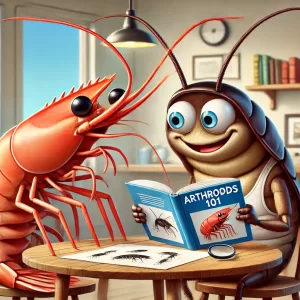Shrimps and Cockroaches
 What Do Shrimps and Cockroaches Have in Common?
What Do Shrimps and Cockroaches Have in Common?
Shrimps and cockroaches might seem worlds apart, with one living in the ocean and the other often invading our homes. However, these two creatures share some surprising similarities. In this article, we’ll explore the fascinating connections between shrimps and cockroaches, as well as their key differences.
Taxonomy and Classification
Arthropods Both shrimps and cockroaches belong to the phylum Arthropoda, a group characterized by their exoskeletons, segmented bodies, and jointed appendages.
- Shrimps: Part of the class Malacostraca, which also includes crabs and lobsters.
- Cockroaches: Part of the class Insecta, which includes a vast number of insect species.
Physical Characteristics
Exoskeleton Both shrimps and cockroaches have a hard exoskeleton made of chitin, which provides protection and support.
Segmentation Their bodies are divided into segments:
- Shrimps: Typically have a segmented body divided into the cephalothorax and abdomen.
- Cockroaches: Have a body divided into the head, thorax, and abdomen.
Habitats
Shrimps
- Marine and Freshwater: Shrimps are found in both marine and freshwater environments. They play a crucial role in the aquatic food chain.
- Habitats: Commonly inhabit coastal areas, rivers, and streams.
Cockroaches
- Terrestrial: Cockroaches are primarily land-dwellers, thriving in warm, moist environments.
- Habitats: Commonly found in homes, forests, and tropical regions.
Diet and Feeding
Shrimps
- Omnivorous: Shrimps have a varied diet, including algae, plankton, and detritus.
- Feeding Behavior: They use their appendages to filter food from the water or scavenge along the ocean floor.
Cockroaches
- Omnivorous: Cockroaches eat a wide range of organic matter, from food scraps to decaying material.
- Feeding Behavior: They have powerful mouthparts to chew through a variety of substances.
Reproduction
Shrimps
- Egg-Laying: Female shrimps lay eggs, which are often carried under their abdomen until they hatch.
- Larvae: The eggs hatch into free-swimming larvae, which eventually develop into adult shrimps.
Cockroaches
- Egg Cases (Oothecae): Female cockroaches produce egg cases, each containing multiple eggs.
- Nymphs: The eggs hatch into nymphs, which undergo several molts before becoming adults.
Common Misconceptions
Shrimps and Cockroaches as Relatives While shrimps and cockroaches are distant relatives within the arthropod phylum, they belong to different classes and have distinct evolutionary paths.
Shrimps in Cuisine vs. Cockroaches as Pests
- Shrimps: Considered a delicacy in many cuisines around the world.
- Cockroaches: Generally seen as pests, although they are consumed in some cultures as a source of protein.
Interesting Facts
Survival Skills
- Shrimps: Can escape predators by quickly flicking their tails and propelling themselves backward.
- Cockroaches: Known for their resilience, can survive without food for weeks and endure harsh conditions.
While shrimps and cockroaches have distinct differences, their shared characteristics as arthropods reveal some fascinating connections. Understanding these similarities and differences can deepen our appreciation for the diversity of life on Earth.
Explore more about the intriguing world of arthropods and learn how to manage cockroach infestations effectively by browsing our other articles and resources. If you’re dealing with a pest problem, consider professional pest control services for expert assistance.
- The Life Span of a Cockroach
- Do Cockroaches Eat Clothes?
- Do Cockroaches Have Teeth?
- Shrimps and Cockroaches
- Will Sleeping with the Light On Keep Cockroaches Away?
- How to get roaches out of your car overnight
- Do Cockroaches Feel Pain?
- How Many Legs Do Cockroaches Have?
- Comparing Cockroach Eggs Size for Different Types of Cockroaches
- Identifying a Cockroach Bite on the Lips or Face
- Black Water Bug Identification and Control
- Why Do Water Bugs Come Out At Night?
- What Does Roach Rash Look Like?
- Can Cockroaches Bite Your Eyelid?
- Can Cockroaches Live in Your Balls?
- How did cockroaches get their name?
- Why Do Cockroaches Shed Their Skin?
- What Smell do Palmetto Bugs Hate?
- Baby Palmetto Bug: Identification and Control
- Cockroach Eggs vs Poop: How to Tell the Difference
- How to Get Rid of Water Bugs
- How Long Can a Cockroach Live Without Air?
- The Lifecycle of the German Cockroach: From Egg to Adult
- Do Mice Eat Roaches
- Wood Roach vs. Cockroach

